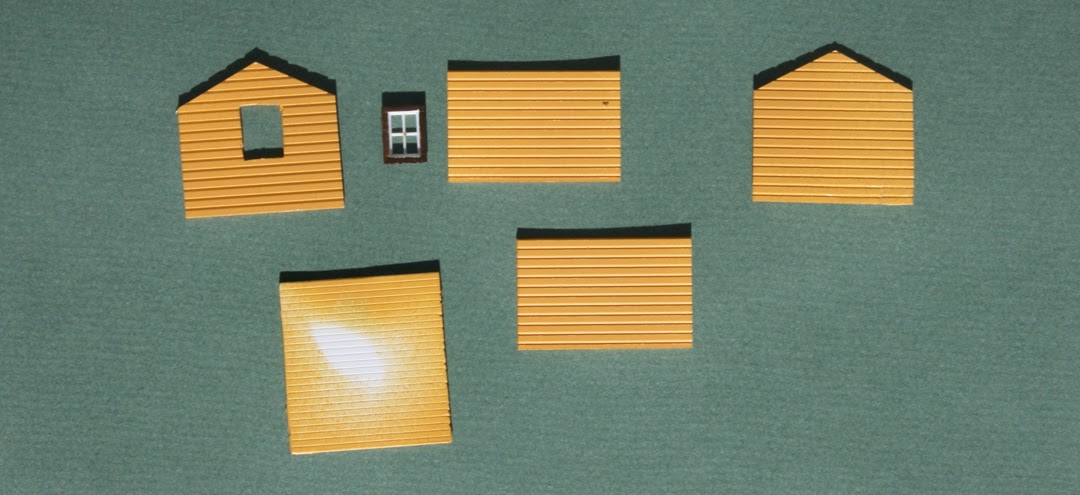In Part 1 (see it at: http://modelingthesp.blogspot.com/2015/04/building-california-tankhouse.html ), I gave the background of these interesting structures, and showed my construction of the bottom part, the upward-tapering enclosure of the tank supports. The structure is completed in this post.
In the prototype tankhouses I have looked at, the upper part, the “upper story,” has the same or almost the same dimensions as the ground footprint of the lower part. To model this, I used Evergreen styrene “Novelty Siding,” 0.040-inch thickness, no. 4083. I simply cut out sides and ends with the same footprint as my first story. In thinking about windows for this upper story, I realized that there seem to be no two of these prototype structures alike in number or placement of windows, so almost any arrangement would be acceptable. I chose a window from my scrapbox, a left-over from a Campbell kit of long ago.
Next the window frame was painted SP Light Brown (Tru-Color Paint no. 163) and the four sides and floor of the upper story were airbrushed SP Colonial Yellow (TCP no. 153). Now I was ready to assemble this top story. (The center of the floor didn’t need to be painted.)
As you can see, I decided to place the window in one end of the top story.
I used my usual styrene structure assembly method, with 1/8-inch square styrene inside all corners. Here are the parts that you saw above, assembled including trim strips, and ready to mate with the first story.
My next job was the roof. I used Rix “Pikestuff” styrene shingled roofing, their part no. 1007, prepainted SP’s standard roof color, Moss Green (Tru-Color no. 154). A narrow strip of flashing along the peak completed the roof. I then used canopy glue to attach the two stories together.
The tank house is now complete except for weathering. It will be part of my stock pen, as the former water source for watering troughs. (I introduced the subject of this stock pen in a prior post; you can read it at this link: http://modelingthesp.blogspot.com/2015/03/a-stock-pen-for-east-shumala.html .) Like many of these tankhouses, it would have been made obsolete as a tank when domestic water became available in small towns. I will show it again when the stock pen complex is complete, which I expect to be soon.
Tony Thompson



I'm curious about your choice of colors; are they intended to suggest that this is an SP-owned structure (and so the stock pen), or just because they are pleasing, and on hand?
ReplyDeleteAs I mentioned in my post about stock pens (link provided in last paragraph above), SP usually owned stock pens along its lines. So yes, the SP colors are intended to be consistent with that.
ReplyDeleteTony Thompson
I really like your tank house model, Tony. The tapered design is my favorite style.
ReplyDeleteTank houses were a common structure found in the citrus and other crop growing areas of California. These were part of the domestic water supply systems for families living in the groves. The system included a well, a windmill to raise water and the tank house for storing water and provide gravity distribution. Their heyday was the 1850s to the 1930s, after which rural electrification provided power for pumping the water which made these structures a little less essential. Eventually municipal water systems provided water to many farm homes, further diminishing the needs for windmill/tank system.
I sent a tank house photo to Richard Walker, whose family had two citrus farms in Orange County. He had this to say,
"Typical water supply to many farm homes built in early 1900s or earlier.
Sometimes situated right next to a well and pump, sometimes not, and then the water would be pumped through a pipeline from a distant well. Redwood stave tanks were employed ranging from 500 to 1,500 gallons (my estimate) elevated
high off the ground for gravity flow. Lower floor was used for washing machine,
wash-up sink, storage, etc."
You also can build the model without enclosing the tank, as seen in this work by
Mic Greenberg from the Kappler Lumber site:
http://www.kapplerusa.com/y2k/kp-gallery-mgreenburg.htm
Yes, that is a model!
Sugar Pine Models once offered an HO scale tank house kit. The product number was 1111. And another model manufacturer (possibly Muir) once made an HO scale model of a tank house.
A message post on my Yahoo group shows a photo of a tank house built by Alain Kap (https://groups.yahoo.com/neo/groups/citrusmodeling/conversations/messages/63230. The tank house is the Krohn Tank house he scratch built following the drawings from the Library of Congress and information in the book Tankhouse, California's Redwood Water Towers From A Bygone Era, by Thomas Cooper.
Thanks, Bob. The Cooper book is very nice, and though I don't own a copy, I looked through it in deciding how to build my tank house. My main inspiration was the many surviving tank houses in the town of Mendocino, where we make weekend visits from time to time. Well worth a look!
ReplyDeleteTony Thompson